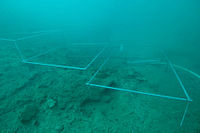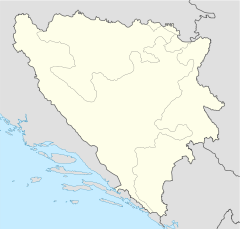- Desilo
-
Desilo is a small valley in southern Bosnia and Herzegovina, located near the Neretva river and the Croatian border. Archaeological investigations in a small lake there in 2007 led to interesting finds of Illyrian boats. Desilo was in antiquity probably connected with Neretva via Lake Hutovo Blato. References to Neretva can be traced as far back as ancient times. In the era of ancient Bosnia and Herzegovina, Neretva was known as Narenta, Narona and Naro(n)[1] [2][3], and was home to the ancient Illyrian tribe of Ardiaei[4] and Daorsi. The river Neretva provided them life, turning them into town builders, ship makers, seafarers and fishermen that were renowned in ancient times.
Contents
In the spring of 2007, Professor Snjezana Vasilj PhD of the University of Mostar excavated 2 Illyrian boats in Desilo, covered with stone-blocks and fragments of Roman wine amphorae. After intense excavations in the area of Hutovo Blato in the autumn of 2008, archaeologists from University of Oslo, Norway together with Dr. Vasilj found the very first traces of an Illyrian trading post from at least the 2nd-1st centuries BC [5]. The find is unique in a European perspective and the archaeologists have concluded that Desilo was an important trading post of great significance for contact between the Illyrians and the Romans. Surprisingly large finds have been made in a short period of time. The archaeologists have discovered the ruins of a settlement, the remains of a harbour that probably functioned as a trading post, as well as many sunken boats, covered with fragments of wine pitchers – so-called amphorae – from the 1st century B.C[6]. The archaeologist Adam Lindhagen, who has a PhD from the University of Lund and has specialised in Roman wine amphorae, says that this is the most important find of all time from the Illyrian areas[7][8].
Pirate theory
The boat finds had been speedily interpreted as proof that the Illyrians were pirates and that the ships had been sunk by the Romans. Although the pirate theory received considerable attention from the press in many parts of Europe, archaeologists Marina Prusac and Adam Lindhagen did not completely agree with this interpretation. Although there certainly were pirate activities along the Adriatic coast, they thought it rather odd that the pirates were so far inland and so near the important Roman colony of Narona. In their opinion Desilo might have been a trading centre. Desilo is located 32 kilometres from the coast on an alluvial plain by the Neretva river. The river is the only traffic artery along the entire Croatian coast that runs into the Bosnia and Herzegovina mountains. It is broad and free-flowing for the first 30 kilometres or so, after which its course becomes narrow. Near Desilo there are also ancient traffic arteries on land in the direction of both Narona, which was first a Greek trading post and then a Roman colony, and the Illyrian settlement of “Daorson” – the present-day Ošanići. Desilo is situated at the innermost point of a quiet bay where it was natural to transfer goods to smaller boats, so the place is perfect for an inner trading harbour. The presumed harbour represents a rare example of a meeting point in this impenetrable landscape.
The harbour
Over the past two thousand years the river has repeatedly changed its bed in the delta. The archaeologists found the remains of the Illyrian trading post under several metres of mud and ooze. It appears that parts of the wall that stuck up from the mud by the water’s edge may have functioned as one of the many quays at the trading post. The wall is 20 metres long and 60 centimetres wide, and is built as a polygonal structure. The wall was solid and stable. The other side was not so well constructed and most likely functioned as a dam. There were a number of mooring holes placed at the same height on the wall, almost like a horizontal band. And as if this was not enough, the archaeologists from the University of Oslo also discovered that there were at least twice as many boats as those that had already been registered. The boats, which the Romans called Lembi, were well known for their fast manoeuvrability. The many pieces of pottery found indicate that this was a major trading post. And last but not least: about a hundred metres from the harbour site they found an Illyrian settlement. Moreover, in collaboration with the land-owner and along with master’s degree student Jo-Simon Frøshaug Stokke, the recently graduated archaeologists Lene Os Johannessen and Ole Christian Aslaksen discovered terrace formations in the mountainside. This find can only be interpreted as indicating the presence of a settlement that presumably existed for several hundred years or even longer before the trade between the Illyrians and the Romans started. Some graves – older than the other finds – were previously discovered close to the settlement. A number of individual finds have also been made in the area: anchor parts, lance tips and fibula, and metal buckles for fastening clothes. Thanks to the clay and the fresh water the objects are surprisingly well preserved. Salt water would have destroyed the wood.
Wine and amphorae
On the lake bed, together with the boats, archaeologists from University of Mostar found hundreds of pieces of wine amphorae of type Lamboglia 2 and as many as 700 lids from these vessels. As archaeologist Adam Lindhagen, who has a PhD from the University of Lund and has specialised in Roman wine amphorae points out, imports from the Roman colony Narona must therefore have been far more extensive than we previously thought. He has analyzed the pottery to find out where the amphorae came from. He can now say that they were exclusively produced along the Dalmatian coast – from where wine was exported to the entire Roman Empire. In exchange for wine the Romans may have bought salt, metal, leather and slaves. The price could have been similar to that in Gaul. According to Diodorus Siculus (100-44 B.C.), the Gauls were happy to swap a slave for a 25-litre amphora of wine [9]. While Professor Vasilj was of the view that all the boats were sunk at the same time in a Roman campaign against Illyrian pirates, amphorae which are later in date than those from the boatwrecks have also been found in the lake, something which might contradict such an assumption [10].
Ritual or war
One big question remains unsolved, and that is why none of the amphorae are whole. They are all in fragments. The Norwegian archaeologists claim that it’s possible Illyrians made ritual offerings to the sea[11] – a well-known phenomenon in Scandinavia during the Iron Age, but this is really a loose theory because it would be the first example ever heard of from the Illyrian area or whole region of eastern Adriatic. Indeed, archaeologists still don't know why the boats were sunk and the pitchers destroyed, but doctor Lindhagen from the University of Lund assume that it's absurd to think that the Romans sank almost a one thousand amphorae containing their own wine. Their explanations is that the amphorae may have been dumped when they’d been emptied. However, piles of horse teeth and bones, Illyrian weaponry like axes and spear tips and pottery have also been found in the water along the boats and amphorae, what gives Professor Snjezana Vasilj PhD and her colleagues from University of Mostar a strong arguments to stick to their Pirate theory and a Roman war campaign against Illyrian pirates, after all, in the Illyrian wars of 229 BC and 219 BC, Rome overran the Illyrian settlements in the Neretva river valley and suppressed the piracy that had made the Adriatic unsafe for commerce[12].
Ardiaei or Narensii
 Desilo achaeological underwater site at Hutovo Blato Nature Park, Bosnia and Herzegovina. (Photo: University of Mostar)
Desilo achaeological underwater site at Hutovo Blato Nature Park, Bosnia and Herzegovina. (Photo: University of Mostar)
Their original homeland is said to have been around modern Neretva river , in present-day Bosnia and Herzegovina. In ancient times this river was known as Narenta/Naro(n)/Narona, and the connotation with the name of an Illyrian tribe Narensii seems obvious. They were called by Romans "Vardiaei"[13]. Narensii (Ardiaei), once an inland tribe, eventually settled on the Adriatic coast[14]. The ancient geographer, Strabo, lists the Ardiaei as one of the three strongest tribes - the other two being the Autariatae and the Dardani. The whole of the mountainous country that stretches alongside Pannonia from the recess of the Adriatic as far as the Rhizonic Gulf and the land of the Ardiaei is Illyrian, falling as it does between the sea and the Pannonian tribes (Strabon, Geographika, 7. 5. 3).
Daorsi
Daors was the name of an Illyrian tribe[15] . Another name of the tribe was Daversi[16].
Cultural identity
Archaeological research on the Illyrians was used politically as the culture-historical glue of the various groups in the former Yugoslavia. Today the focus is more on the differences between the Illyrian peoples. The neutral term ‘Illyrian’ was applied to all ethnic groups in the former Yugoslavia. The Illyrians have been described as warriors, and little focus has been placed on peaceful connections between the Illyrians and the Romans. So it’s important to be able to reveal peaceful relations and to show that the Illyrians had come a long way in their cultural contact with other nations, at the same time as there were great differences between the Illyrian tribes. Discovery is therefore important for understanding cultural identities in the Balkans in ancient times.
See also
- Neretva
- Hutovo Blato
- Krupa
- List of Illyrian tribes
- List of Illyrian cities
- Daorson
- Daorsi
- History of Bosnia and Herzegovina
- History of the Balkans
References
- ^ Archeological Museum of Narona
- ^ The Ancient City of Narona
- ^ Neven Kazazovic, Tajne Neretve
- ^ John Wilkes, "The Illyrians"
- ^ http://www.apollon.uio.no/vis/art/2008_4/artikler/illyrer_english
- ^ "Bosnian archaeologists discover fabled ships". iol.co.za. http://www.int.iol.co.za/index.php?set_id=1&click_id=588&art_id=nw20070320140758925C772088. Retrieved 2009-03-17.
- ^ "The world’s first Illyrian trading post found". Apollon - University of Oslo. http://www.apollon.uio.no/vis/art/2008_4/artikler/illyrer_english. Retrieved 2009-03-17.
- ^ "Unique Archaeological Discovery In Balkan: World’s First Illyrian Trading Post Found". Science Daily. http://www.sciencedaily.com/releases/2008/12/081208092151.htm. Retrieved 2009-03-17.
- ^ Diod. Sic. 5. 26. 3
- ^ http://www.apollon.uio.no/vis/art/2008_4/artikler/illyrer_english
- ^ http://www.apollon.uio.no/vis/art/2008_4/artikler/illyrer_english
- ^ Wilkes, J. J. The Illyrians, 1992, p. 120, ISBN 0-631-19807-5.,Page 158,"... ' Illyrian success continued when command passed to Agron's widow Teuta, who granted individual ships a licence to universal plunder. In 231 ac the fleet and army attacked Ells and Messenia ..."
- ^ Wilkes, J. J. The Illyrians, 1992,ISBN 0-631-19807-5..page 216,"The Ardiaei, or Vardaei as they were known to the Romans, `once the ravagers of Italy' and now reduced to a mere ..."
- ^ Wilkes, J. J. The Illyrians, 1992,ISBN 0-631-19807-5.,page 188,"probably the result of pressure from new Illyrian groups, including the Ardiaei and Delmatae, moving towards the Adriatic. ...""
- ^ Wilkes, J. J. The Illyrians, 1992,ISBN 0-631-19807-5,From back matter,"... "`Surveys of ships on coins of the Daors tribe'"
- ^ Wilkes, J. J. The Illyrians, 1992,ISBN 0-631-19807-5,page 216,"... to the Romans, `once the ravagers of Italy' and now reduced to a mere 20 decuriae, and the Daorsi or Daversi, ..."
External links
- Bosnia and Herzegovina Commission for Preservation of National Monuments
- Wine route Herzegovina
- Hutovo Blato Nature Park
- Hutovo Blato Nature Park — Network of Adriatic Parks
- Archeological Museum of Narona in Vid, Croatia
- Troy - possible locations within Neretva valley
- Geografija.hr
- Čapljina municipality
Categories:- History of Bosnia and Herzegovina
- Illyria
- Archaeology of Bosnia and Herzegovina
- Archaeological sites in Bosnia and Herzegovina
- Nature parks of Bosnia and Herzegovina
- Conservation in Bosnia and Herzegovina
Wikimedia Foundation. 2010.

